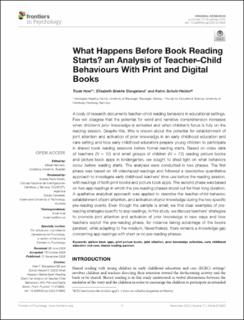| dc.contributor.author | Hoel, Trude | |
| dc.contributor.author | Stangeland, Elisabeth Brekke | |
| dc.contributor.author | Schulz-Heidorf, Katrin | |
| dc.date.accessioned | 2021-01-26T12:06:41Z | |
| dc.date.available | 2021-01-26T12:06:41Z | |
| dc.date.created | 2020-11-18T14:34:44Z | |
| dc.date.issued | 2020-11 | |
| dc.identifier.citation | Hoel T, Stangeland EB and Schulz-Heidorf K (2020) What Happens Before Book Reading Starts? an Analysis of Teacher–Child Behaviours With Print and Digital Books. Front. Psychol. 11:570652. | en_US |
| dc.identifier.issn | 1664-1078 | |
| dc.identifier.uri | https://hdl.handle.net/11250/2724767 | |
| dc.description.abstract | A body of research documents teacher–child reading behaviors in educational settings. Few will disagree that the potential for word and narrative comprehension increases when children’s prior knowledge is activated and when children’s focus is fully on the reading session. Despite this, little is known about the potential for establishment of joint attention and activation of prior knowledge in an early childhood education and care setting and how early childhood educators prepare young children to participate in shared book reading sessions before formal reading starts. Based on video data of teachers (N = 12) and small groups of children (N = 72) reading picture books and picture book apps in kindergarten, we sought to shed light on what behaviors occur before reading starts. The analyses were conducted in two phases. The first phase was based on 48 videotaped readings and followed a descriptive quantitative approach to investigate early childhood teachers’ time use before the reading session, with readings of both print books and picture book apps. The second phase was based on two app readings in which the pre-reading phases stood out for their long duration. A qualitative analytical approach was applied to describe the teacher–child behavior, establishment of joint attention, and activation of prior knowledge during the two specific pre-reading events. Even though the sample is small, we find clear examples of pre-reading strategies specific to app readings. In this study, we discuss teachers’ strategies to promote joint attention and activation of prior knowledge in new ways and how teachers exploit the pre-reading phase, for instance taking advantage of the books paratext, while adapting to the medium. Nevertheless, there remains a knowledge gap concerning app readings with short or no pre-reading phases. | en_US |
| dc.language.iso | eng | en_US |
| dc.publisher | Frontiers Media S.A | en_US |
| dc.rights | Navngivelse 4.0 Internasjonal | * |
| dc.rights.uri | http://creativecommons.org/licenses/by/4.0/deed.no | * |
| dc.subject | lesevitenskap | en_US |
| dc.subject | ebøker | en_US |
| dc.subject | papirbøker | en_US |
| dc.subject | bildebøker | en_US |
| dc.subject | billedbøker | en_US |
| dc.subject | barnehagelærerutdanning | en_US |
| dc.title | What Happens Before Book Reading Starts? an Analysis of Teacher–Child Behaviours With Print and Digital Books | en_US |
| dc.type | Peer reviewed | en_US |
| dc.type | Journal article | en_US |
| dc.description.version | publishedVersion | en_US |
| dc.rights.holder | © 2020 Hoel, Stangeland and Schulz-Heidorf. | en_US |
| dc.subject.nsi | VDP::Humaniora: 000 | en_US |
| dc.source.volume | 11 | en_US |
| dc.source.journal | Frontiers in Psychology | en_US |
| dc.identifier.doi | 10.3389/fpsyg.2020.570652 | |
| dc.identifier.cristin | 1849320 | |
| dc.relation.project | Universitetet i Stavanger: IN-10986 | en_US |
| dc.relation.project | Norges forskningsråd: 260356 | en_US |
| dc.relation.project | Norges forskningsråd: 275576 | en_US |
| cristin.ispublished | true | |
| cristin.fulltext | original | |
| cristin.qualitycode | 2 | |

